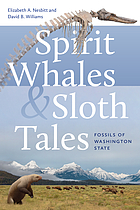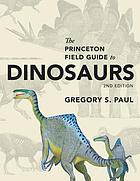
From trilobites near the Idaho border and primitive horses on the Columbia Plateau to giant bird tracks near Bellingham and curious bear-like beasts on the Olympic Peninsula, fossils across Washington State are filled with clues of past life on Earth. With abundant and well-exposed rock layers, the state has fossils dating from Ice Age mammals only 12,000 years old back to marine invertebrates more than 500 million years old. In Spirit Whales and Sloth Tales, renowned paleontologist Elizabeth A. Nesbitt teams up with popular science writer David B. Williams to offer a fascinating, richly illustrated tour through more than a half billion years of natural history. Following an introduction to key concepts, twenty-four profiles?each featuring a unique plant, animal, or environment?tell the incredible stories of individual fossils, many of which are on display in Washington museums. The spectacular paleontology of Washington is brought to life with details of the fossils' discovery and extraction, their place in geological time, and the insights they provide into contemporary issues like climate change and species extinction.

One of the most geologically complex and diverse states, California spent much of the age of dinosaurs under water. While most of the fossils found in the state are those of reptiles that lived in the sea (thalattosaurs, ichthyosaurs, mosasaurs, plesiosaurs, and turtles), some are those of birds and pterosaurs that soared above it. Other fossils come from terrestrial animals that died and were washed into the ocean. These include turtles, crocodiles, lizards, and dinosaurs such as armored ankylosaurs, duck-billed hadrosaurs, and a variety of carnivorous dinosaurs. Richard Hilton is the first to tell the unsung story of the dinosaurs and reptiles of land, sea, and sky that lived in California and Baja California during the Mesozoic era (245 million-65 million years ago), in addition to the history of their discovery. Vibrantly illustrated with more than three hundred photographs, paintings, and drawings, this book provides geological and environmental details, describes the significance of the major fossils, and chronicles the adventures involved in the discovery, preparation, and publishing of the finds.Hilton also includes accounts of the scientists, teachers, students, ranchers, and weekend fossil hunters who endured (and continue to endure) harsh weather, fires, wild animals, and the usual challenges of fieldwork to collect fossil remains and make major discoveries. These enthusiasts managed to safeguard an abundance of fossil resources, some of which would otherwise have been destroyed by quarrying, paving, and housing developments. "Dinosaurs and Other Mesozoic Reptiles of California" takes this legacy one step further by documenting information about the fossils and their finders in accessible prose and vivid artistic renderings, creating a valuable contribution to our understanding of California s prehistoric past."

Dinosaurs, however toothy, did not rule the earth-and neither do humans. But what were and are the true potentates of our planet? Insects, says Scott Richard Shaw-millions and millions of insect species. Starting in the shallow oceans of ancient Earth and ending in the far reaches of outer space-where, Shaw proposes, insect-like aliens may have achieved similar preeminence-Planet of the Bugs spins a sweeping account of insects' evolution from humble arthropod ancestors into the bugs we know and love (or fear and hate) today. Leaving no stone unturned, Shaw explores how evolutionary innovations such as small body size, wings, metamorphosis, and parasitic behavior have enabled insects to disperse widely, occupy increasingly narrow niches, and survive global catastrophes in their rise to dominance. Through buggy tales by turns bizarre and comical-from caddisflies that construct portable houses or weave silken aquatic nets to trap floating debris, to parasitic wasp larvae that develop in the blood of host insects and, by storing waste products in their rear ends, are able to postpone defecation until after they emerge-he not only unearths how changes in our planet's geology, flora, and fauna contributed to insects' success, but also how, in return, insects came to shape terrestrial ecosystems and amplify biodiversity. Indeed, in his visits to hyperdiverse rain forests to highlight the current insect extinction crisis, Shaw reaffirms just how crucial these tiny beings are to planetary health and human survival. In this age of honeybee die-offs and bedbugs hitching rides in the spines of library books, Planet of the Bugs charms with humor, affection, and insight into the world's six-legged creatures, revealing an essential importance that resonates across time and space.

In the days when dinosaurs dominated the earth, their marine counterparts - every bit as big and ferocious - reigned supreme in prehistoric seas. In this book, Richard Ellis takes us back to the Mesozoic era to resurrect the fascinating lives of these giant seagoing reptiles. fierce predators, speculates on their habits, and tells how they eventually became extinct - or did they? He traces the 200-million-year history of the great ichthyosaurs, plesiosaurs and mosasaurs who swam the ancient oceans - and who may, according to some, still frequent the likes of Loch Ness. animal that looked like a crocodile crossed with a shark the size of a small yacht. With its impossibly long neck, Plesiosaurus conybeari has been compared to a giant snake threaded through the body of a turtle. At a length of nearly 60 feet, Mosasaurus hoffmanni boasted powerful jaws that could crunch up even the hardest-shelled giant sea turtle. And Kronosaurus queenslandicus, perhaps the most formidable of the lot, had a skull nine feet long - more than twice that of Tyrannosaurus rex - with teeth to match. reconstruct their lives and habitats. Their fossils have been found all over the world - in Europe, Australia, Japan and even Kansas - in lands that once lay on the floors of Jurassic and Triassic seas. Along the way, the book also provides intriguing insights into and entertaining tales about the work, discoveries and competing theories that compose the world of vertebrate paleontology. The text is also accompanied by Ellis' own illustrations of how these creatures probably appeared and, through these likenesses, we are invited to speculate on their locomotion, their predatory habits and their lifestyles.

Revised, updated, and expanded with the latest interpretations and fossil discoveries, the second edition of Oceans of Kansasadds new twists to the fascinating story of the vast inland sea that engulfed central North America during the Age of Dinosaurs. Giant sharks, marine reptiles called mosasaurs, pteranodons, and birds with teeth all flourished in and around these shallow waters. Their abundant and well-preserved remains were sources of great excitement in the scientific community when first discovered in the 1860s and continue to yield exciting discoveries 150 years later. Michael J. Everhart vividly captures the history of these startling finds over the decades and re-creates in unforgettable detail these animals from our distant past and the world in which they lived--above, within, and on the shores of America's ancient inland sea.

The Grand Staircase-Escalante National Monument in Utah is the location of one of the best-known terrestrial records for the late Cretaceous. A major effort in the new century has documented over 2,000 new vertebrate fossil sites, provided new radiometric dates, and identified five new genera of ceratopsids, two new species of hadrosaur, a probable new genus of hypsilophodontid, new pachycephalosaurs and ankylosaurs, several kinds of theropods (including a new genus of oviraptor and a new tyrannosaur), plus the most complete specimen of a Late Cretaceous therizinosaur ever collected from North America, and much more. At the Top of the Grand Staircase: The Late Cretaceous of Southern Utah documents this major stepping stone toward a synthesis of the ecology and evolution of the Late Cretaceous ecosystems of western North America.

The revolution in science that is transforming our understanding of dinosaurs In just the past twenty years, we have learned more about dinosaurs than we did in the previous two centuries. This book describes the extraordinary advances in palaeontology that are beginning to solve many of the mysteries surrounding these marvelous prehistoric creatures, including their mating habits, ways of communicating, skin color, migration patterns, and extinction. How did dinosaurs rear their young? What did they eat? What did T. rex actually do with those tiny arms? David Hone draws on his own discoveries at the forefront of dinosaur science to illuminate these and other questions. Each chapter in this lively and informative book covers a key topic in dinosaur science, such as origins, diversity, evolution, habitats, anatomy, behaviour, ecology and dinosaur descendants--the birds. For each topic, Hone discusses the history of what palaeontologists thought in the past, the new insights we are gleaning from recent fossil finds and the latest technologies and the gaps in our knowledge that still remain. He shares his own predictions about the research areas that may produce the next big ideas in dinosaur science and addresses the unknowns we may never solve. How Fast Did T. rex Run? reveals everything we now know about dinosaurs--and everything we don't--and charts thrilling new directions for tomorrow's generation of dinosaur scientists.
IMPORTANT: Be sure to review the search strategies on this page for suggestions on what to type into the database!
 Ancient Creatures
by
Ancient Creatures
by
 The Princeton Field Guide to Dinosaurs
by
The Princeton Field Guide to Dinosaurs
by
The Holman Library One Search looks for information in ALL of our resources at once.
Use the search tips on this page for suggestions on how to use keywords effectively in a database.
IMPORTANT: Using broad search terms can return books and other sources that contain information on a range of extinct vertebrates and invertebrates, while a search using your specific animals may return very little.
Click on image to enlarge
My search of the keywords cretaceous AND invertebrates returned over 9000 different sources, including newspaper articles, books, reference entries, and articles.
To learn more about a source and/or to find the Subject Terms associated with that work, click on the title of the source. That opens up the record where you can learn lots about a source without having to read it first. That's useful!
You will also find Subject Terms associated with the source. These can be a useful research tool, as a good subject term will connect you to other things that library has on that subject!
Try looking for resources in individual databases.
Be sure to assess all your sources of information, particularly those you find on the web.
Below is a list of some websites that may be useful for this project.
Explore Google Arts and Culture for paleontology museums:
Many of the resources you've already found and used have provided maps of regions in which the dinosaurs and other animal fossils were found.
Here are a few additional options.

As GRC students you may borrow books from other libraries and have them sent to you at GRC free of charge.
Use the range of resources included on this page to find information on your animals, eras, and people.
Type in the name of an animal, geological era, or other key idea or name you want to learn about. Search tips:
Keep your search terms simple. Use keywords rather than complex phrases.
Put phrases in quotation marks to search words in a phrase together.
Use AND to connect and focus key ideas.
Use OR to expand your search when either will work.
Use truncation (*) to search for all forms of a root word.
Try broad terms to find sources that contain information on your animal, as well as other animals.
Try narrower terms to find sources on specific topics.